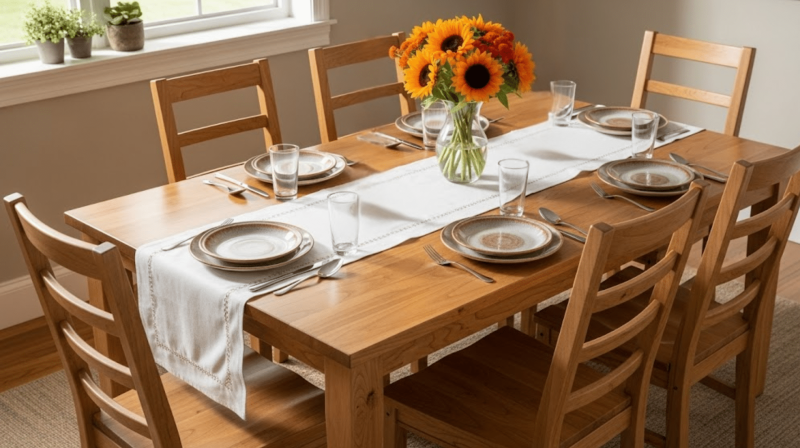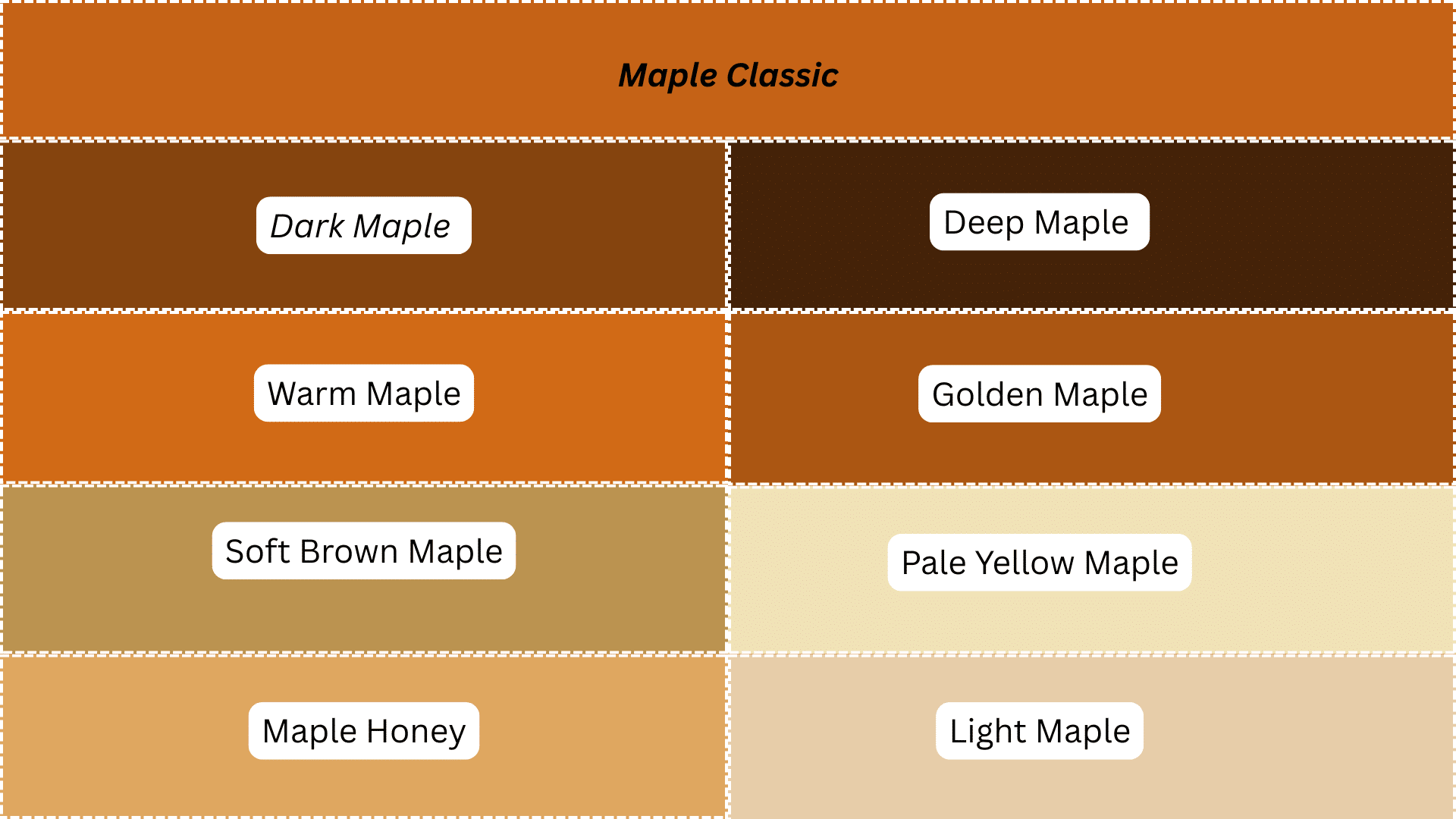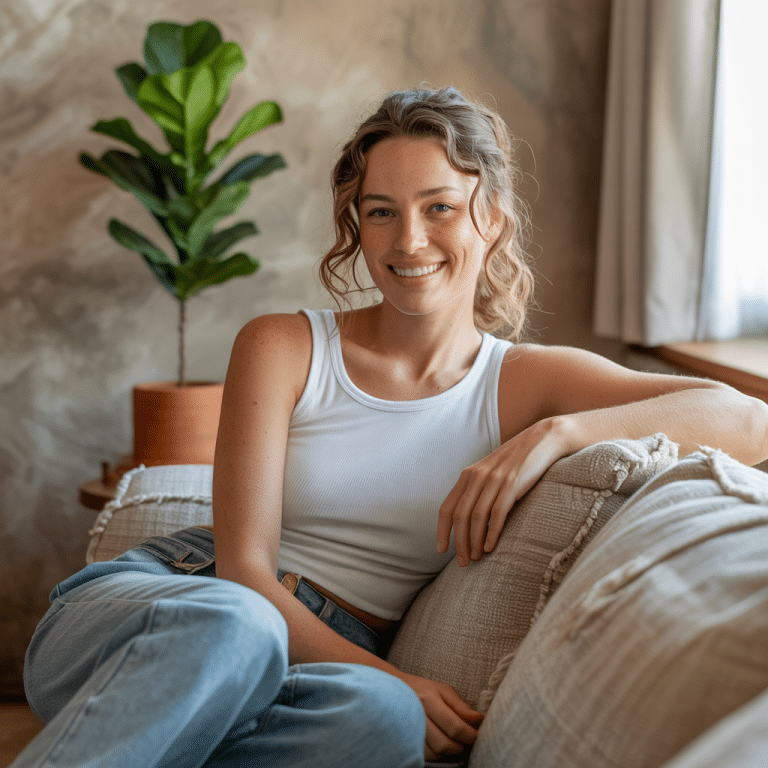I know how frustrating it can be when you’re planning a furniture makeover and can’t find the right maple stain color.
You spend hours browsing online, but the colors never look the same in real life.
I’m going to show you a complete maple stain color chart that takes the guesswork out of your next project. No more costly mistakes or disappointing results.
In this blog, I’ll walk you through the most popular maple stain color chart and help you pick the perfect shade for your specific furniture piece.
You’ll also learn the pros and cons of each stain color and the factors affecting them.
What is a Maple Stain Color Chart?
A Maple Stain Color Chart is essentially a visual guide that shows different stain colors applied specifically to maple wood.
As someone who works with wood finishes, I find these charts really helpful because maple is a dense hardwood with a tight grain that tends to absorb stain unevenly, causing blotchiness.
The chart lets me see how various stains from light walnut and gray to darker espresso tones will look on maple’s natural light, creamy surface before I commit.
This way, I can pick the stain that matches my project’s style and lighting conditions perfectly.
It’s a useful tool to avoid surprises and achieve the exact warmth or modern look I want with my maple wood pieces.
Finishing Maple Wood vs. Maple Color: What is the Difference?
When working with maple wood, it’s easy to confuse finishing maple wood with maple color, but they refer to two different things. The former deals with the treatment process that improves the wood’s durability and beauty, while the latter refers to a specific hue that resembles natural maple wood, often used in stains or paints
| Aspect | Finishing Maple Wood | Maple Color |
|---|---|---|
| Definition | A process involving sanding, staining, sealing, and topcoating real maple wood. | A color tone used to mimic or complement the natural appearance of maple wood. |
| Purpose | Enhances protection, appearance, and longevity of real maple wood surfaces. | Achieves the aesthetic look of maple on other materials or wood types. |
| Material Involved | Real maple wood (hard or soft varieties). | Any surface (wood, laminate, metal, plastic) being stained or painted. |
| Application Process | Labor-intensive: prep, sand, stain, seal, and finish. | Simple: apply maple-colored stain, paint, or veneer. |
| Outcome | Highlights the grain and depth of actual maple wood. | Delivers a maple-like appearance without the texture of real wood. |
| Use Cases | High-end furniture, cabinetry, and flooring. | Budget-friendly furniture, veneers, and prefabricated surfaces. |
| Customizability | Highly customizable with various finish types (matte, gloss, satin). | Limited to available shades of maple in stains or paints. |
Color Characteristics of Maple Wood
Maple wood has unique properties that affect how stains appear on its surface. Understanding these characteristics will help you choose the right stain and achieve the results you want.
1. Natural Light Color
Maple wood starts with a naturally light, creamy white appearance. This pale base makes it perfect for both light and dark stains.
The light color means stains will show up true to their intended shade. I find this neutral starting point gives you more flexibility than darker woods. It’s like working with a blank canvas for your staining project.
2. Slight Reddish Undertones
Look closely at raw maple and you’ll notice subtle reddish undertones beneath the surface. These warm hints become more visible when you apply certain stains.
The reddish tones can enhance warm-colored stains beautifully. However, they might clash with cooler stain colors. I always consider these undertones when selecting my final stain color choice.
3. Color Variations in Sapwood and Heartwood
Maple wood shows clear differences between its sapwood and heartwood sections. The sapwood appears lighter and creamier in color. The heartwood tends to be slightly darker with more pronounced grain patterns.
These variations can create an interesting contrast in your finished piece. Some woodworkers love this natural variation while others prefer more uniform coloring throughout.
4. Susceptibility to Blotching
Maple is notorious for absorbing stain unevenly, creating blotchy results. Dense grain areas resist stain while softer areas soak it up quickly. This creates an uneven, spotted appearance that many find unappealing.
I always recommend using a pre-stain wood conditioner to minimize this issue. Proper preparation makes all the difference in achieving smooth, even stain coverage.
5. Aging and Color Change Over Time
Fresh maple wood will naturally darken as it ages and gets exposed to light. The creamy white color gradually shifts to a warm honey tone over the years.
This natural aging process affects how your stained piece will look long-term. I tell my clients to expect some color evolution. The good news is that aged maple typically becomes more beautiful with time
Most Popular Maple Stain Color Chart
Best Maple Stains for Your Wood Projects
I’ve tested dozens of maple stain colors over the years, and these nine shades consistently deliver beautiful results.
Each color brings out different characteristics in maple wood, from warm honey tones to rich chocolate browns. Let me walk you through my top picks with all the details you need.
1. Maple Classic
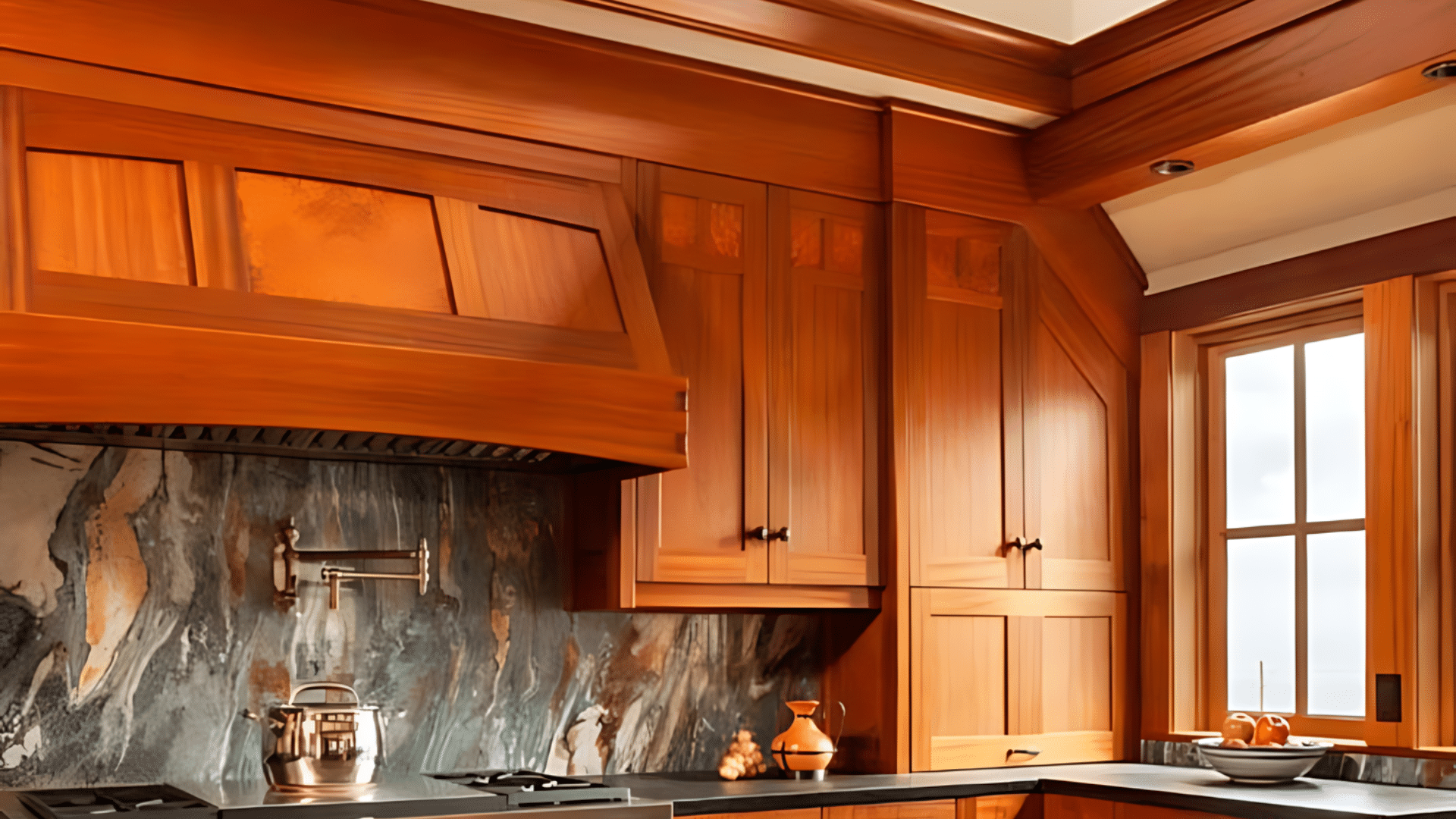
I consider Maple Classic (#C46316) the gold standard for maple furniture.
This rich, medium-brown stain has an LRV of 22, making it perfect for both light and dark rooms. The color brings out the maple’s natural grain patterns beautifully without overwhelming the wood’s character.
This stain works exceptionally well on kitchen cabinets and dining room furniture. I’ve used it countless times, and clients always love how it adds warmth without being too dark or too light.
- Pros: Works well with most home décor styles, hides minor wood imperfections, and provides consistent coverage across different maple wood grades.
- Cons: Can appear slightly orange in certain lighting conditions, and may require two coats on harder maple varieties for even coverage.
2. Dark Maple
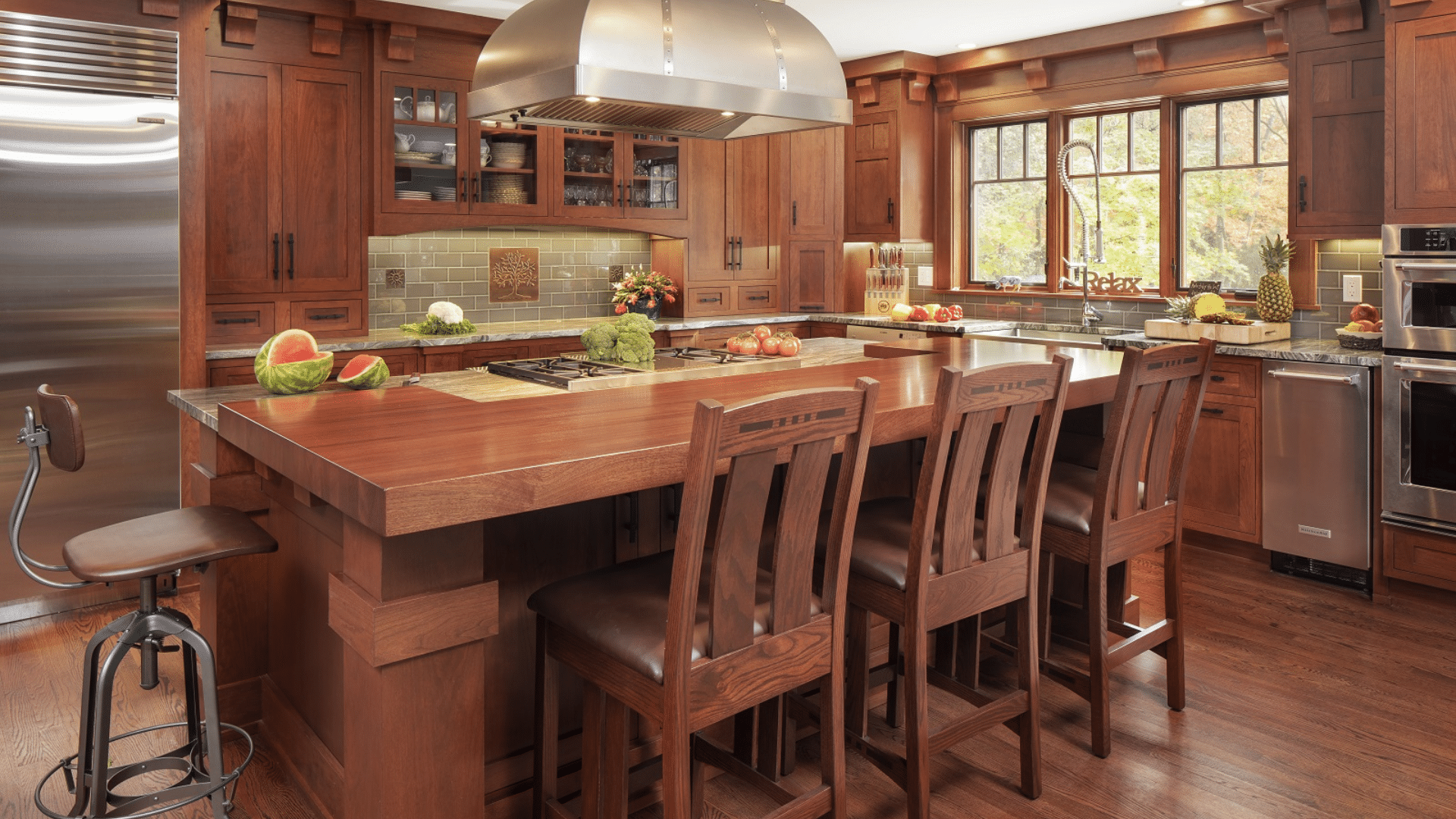
Dark Maple (#85440F) creates a sophisticated, coffee-like finish that I love for formal furniture pieces. With an LRV of 15, this stain adds drama and depth to any room while maintaining maple’s distinctive grain pattern.
I recommend Dark Maple for statement pieces like bookcases, entertainment centers, or formal dining sets.
The color photographs are beautiful and always impress guests. Just remember to use good lighting to showcase the rich tones properly
- Pros: Creates a luxurious appearance, pairs beautifully with light-colored walls, and helps smaller furniture pieces make a bold statement in large rooms.
- Cons: Shows dust and fingerprints more easily than lighter stains, and can make small rooms feel cramped if used extensively.
3. Deep Maple
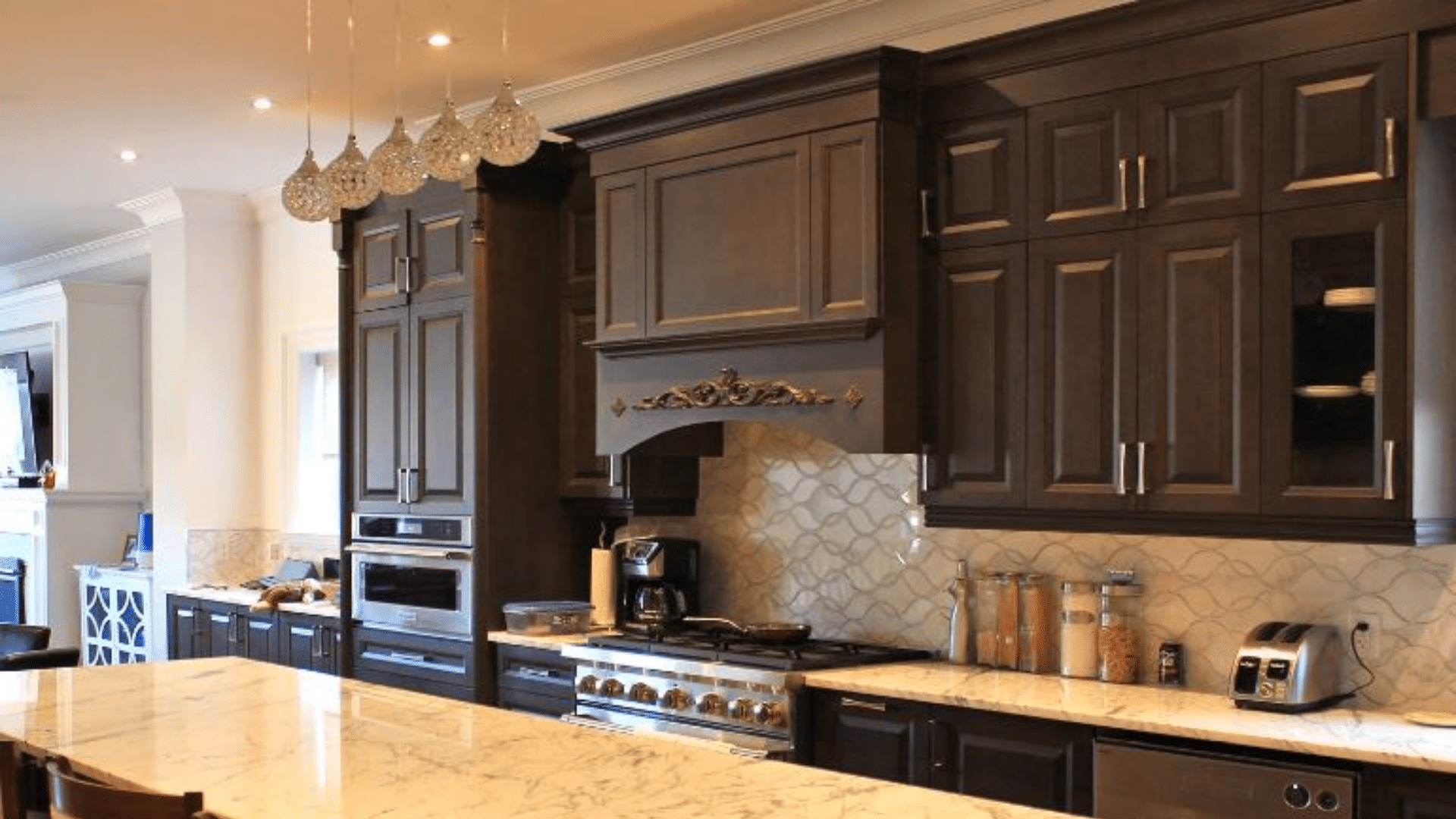
Deep Maple (#452308) is my go-to choice when clients want something truly dramatic. This nearly-black stain has an LRV of 8, creating an almost ebony-like finish that still lets maple’s grain show through subtly.
I use Deep Maple sparingly, usually for accent pieces or in rooms with plenty of white and light colors. It’s particularly striking on maple picture frames or decorative boxes where you want maximum visual impact.
- Pros: Creates stunning contrast with light décor, perfect for modern and contemporary styles, and makes inexpensive maple look like premium hardwood.
- Cons: Requires multiple coats for even coverage, shows every speck of dust, and can completely overwhelm small spaces or rooms with limited natural light.
4. Warm Maple
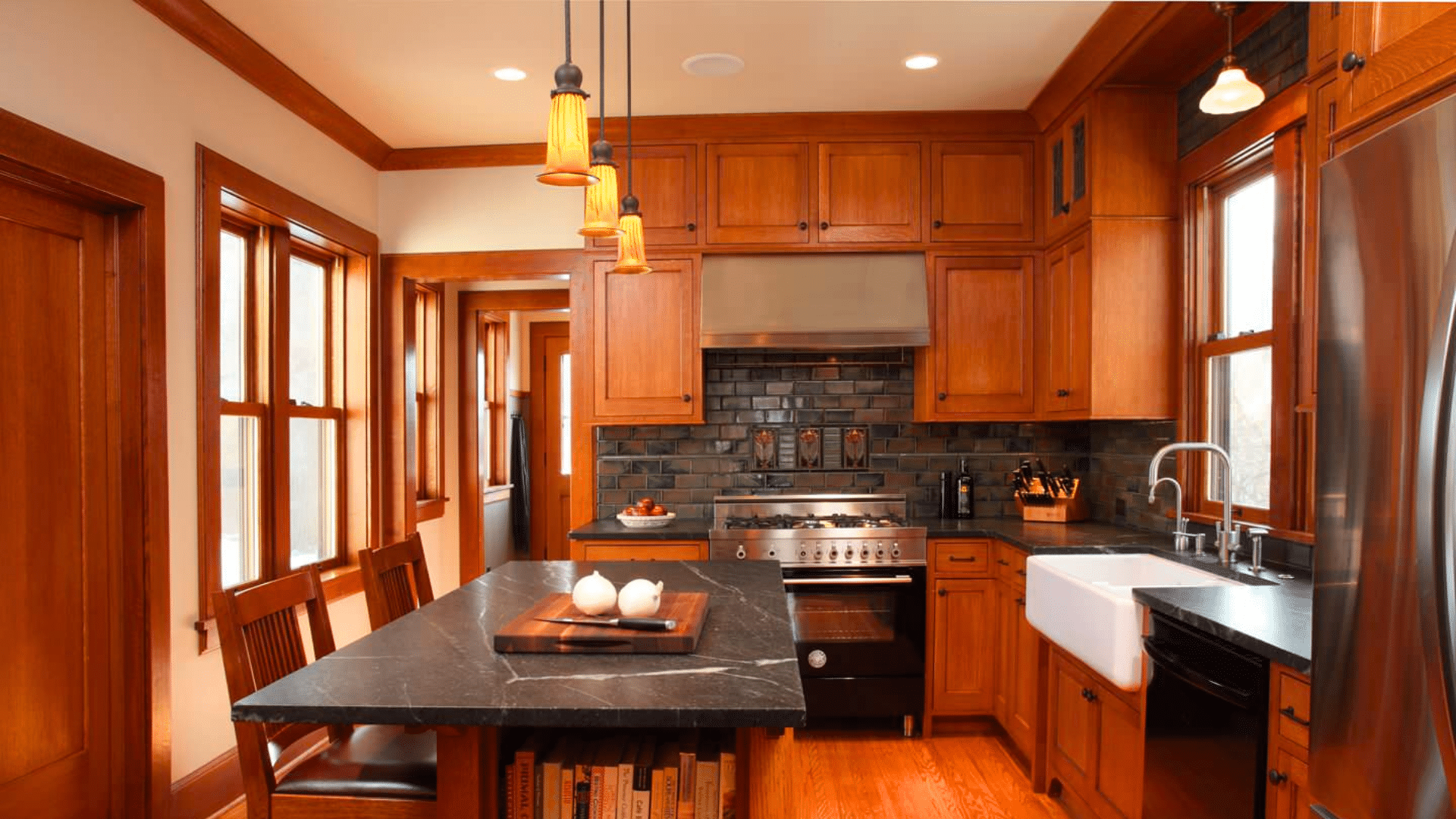
Warm Maple (#D16B17) reminds me of autumn leaves and cozy fireplaces. This amber-toned stain has an LRV of 28, making it bright enough for everyday use while still adding character to plain maple wood.
I love using Warm Maple on kitchen islands, breakfast nooks, and family room furniture. The color makes spaces feel inviting and comfortable, perfect for areas where families gather and create memories together.
- Pros: Creates a welcoming, homey atmosphere, complements both traditional and rustic décor styles, and enhances maple’s natural warmth without looking artificial.
- Cons: Can clash with cool-toned paint colors, may appear too yellow under fluorescent lighting, and requires careful application to avoid streaking.
5. Golden Maple
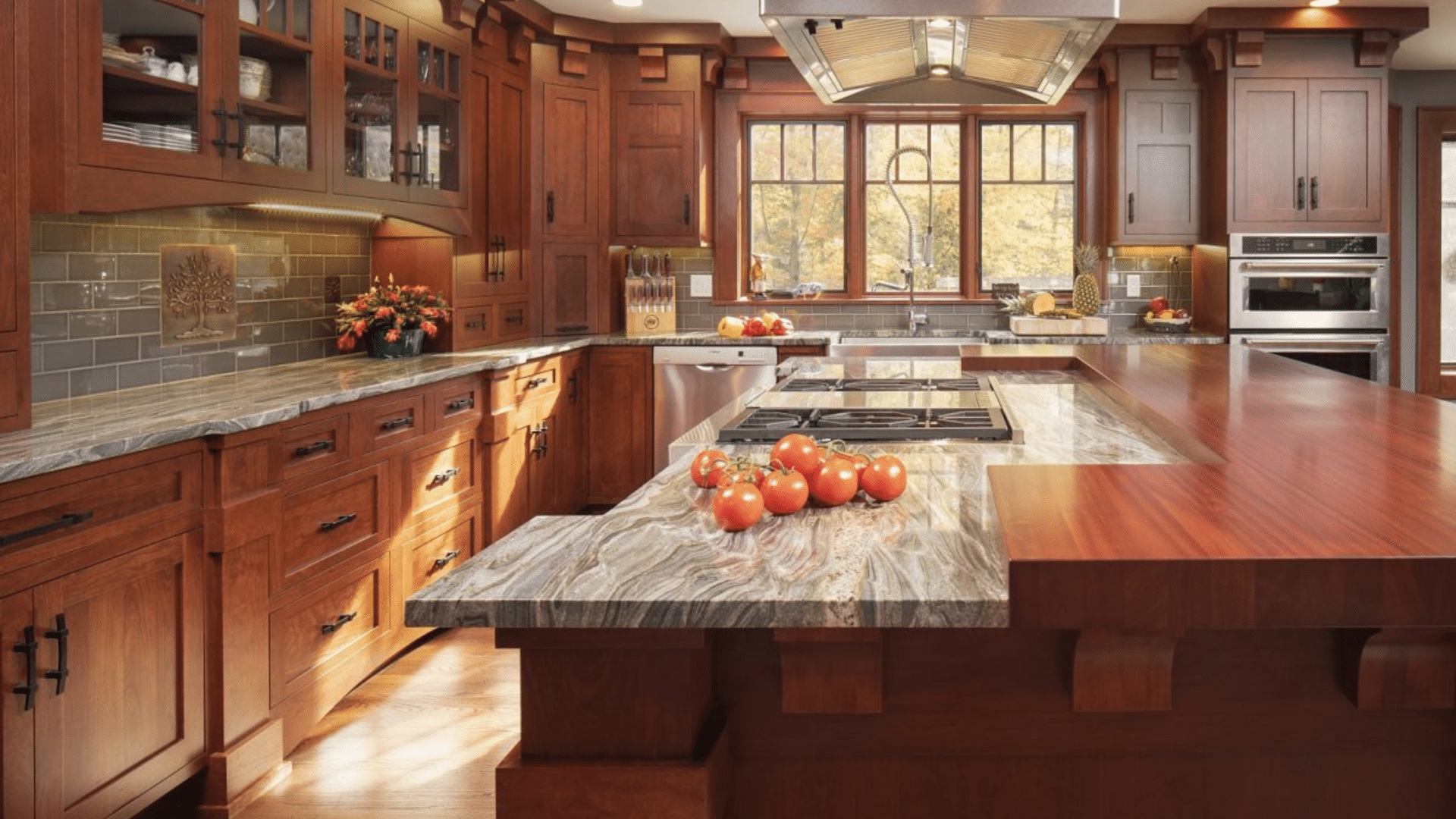
Golden Maple (#AB5713) strikes the perfect balance between classic and contemporary styling. With an LRV of 20, this honey-gold stain brings out maple’s natural beauty while adding just enough color to make pieces stand out.
I recommend Golden Maple for first-time furniture refinishers because it’s forgiving and always looks good. It’s my standard choice for bedroom furniture and home office pieces where you want quality without being flashy.
- Pros: Versatile enough for any room, ages beautifully over time, and works well with both warm and cool accent colors in your home décor.
- Cons: Can look bland if not properly sealed, may require touch-ups in high-traffic areas, and doesn’t provide much contrast for rooms with similar wood tones.
6. Soft Brown Maple
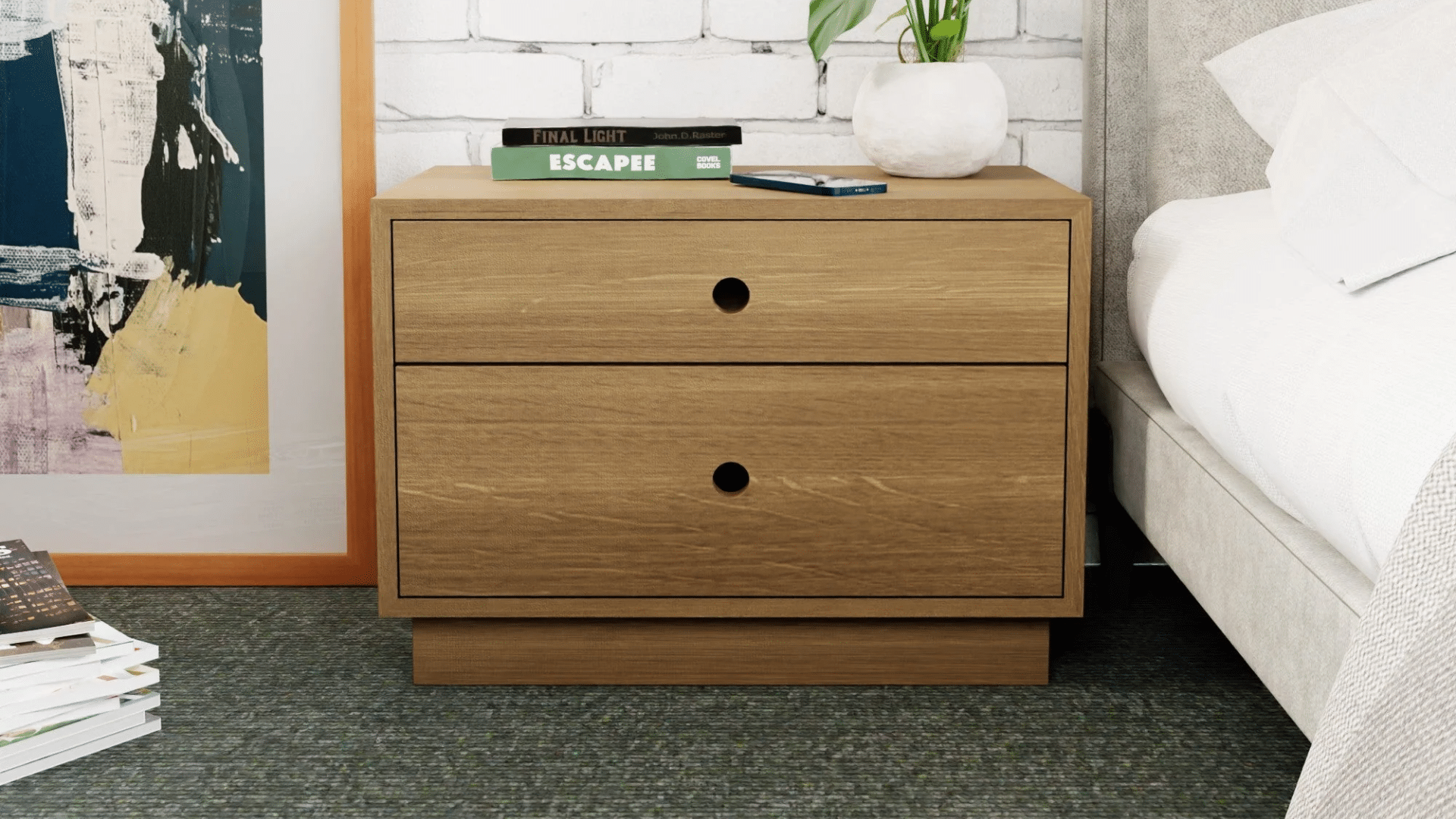
Soft Brown Maple (#BB9351) creates a gentle, weathered look that I adore for farmhouse and cottage-style pieces. This muted brown stain has an LRV of 35, keeping rooms bright while adding subtle character.
I use Soft Brown Maple frequently for kitchen tables, benches, and casual dining sets. The color works beautifully with distressing techniques and pairs perfectly with white or cream-colored paint for mixed-finish furniture projects.
- Pros: Perfect for shabby chic and farmhouse styles, hides wear and tear naturally, and creates a relaxed, lived-in appearance that feels authentic.
- Cons: May look washed out in rooms with lots of natural light, can appear grayish under certain lighting conditions, and doesn’t provide much drama for formal spaces.
7. Pale Yellow Maple

Pale Yellow Maple (#F0E2B6) is barely a stain at all, more like a protective tint that enhances maple’s natural pale color.
With an LRV of 75, this light finish keeps spaces bright and airy.
I choose Pale Yellow Maple when clients want to preserve maple’s natural beauty while still adding some protection. It’s ideal for children’s furniture, craft room storage, and pieces that need to blend into light, neutral spaces seamlessly.
- Pros: Maintains maple’s light, natural appearance, perfect for Scandinavian and minimalist décor, and won’t clash with any color scheme in your home.
- Cons: Provides minimal protection against UV damage, shows every scratch and dent, and may look unfinished compared to darker-stained pieces.
8. Maple Honey
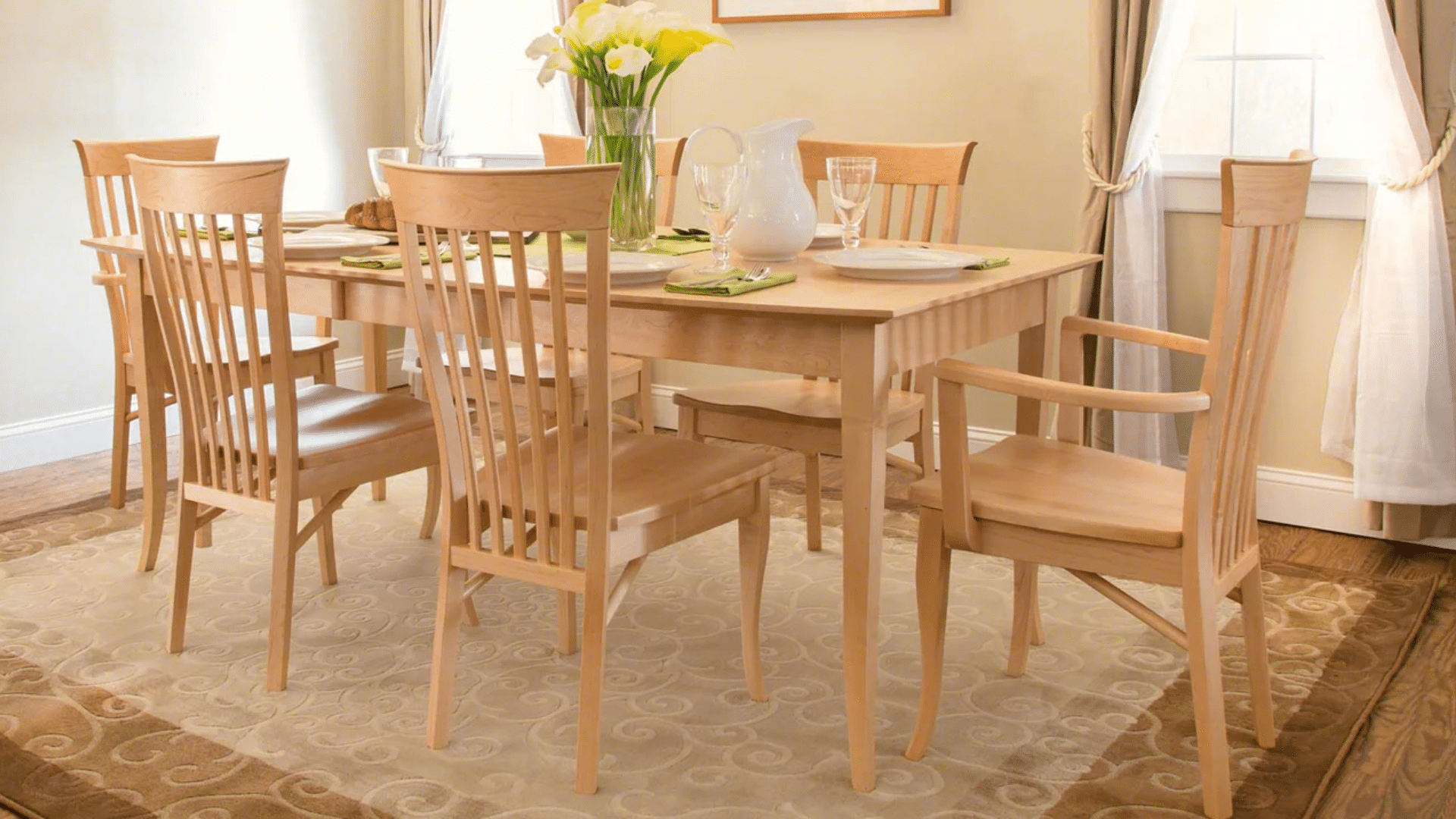
Maple Honey (#DFA661) captures the warm, golden glow of actual honey, creating furniture that feels both classic and timeless. This medium-light stain has an LRV of 45, providing warmth without overwhelming your space.
I find Maple Honey works wonderfully for traditional living room furniture, hope chests, and antique reproductions.
- Pros: Creates a cozy, traditional look, enhances maple’s grain beautifully, and works well in both formal and casual settings throughout your home.
- Cons: Can yellow over time with sun exposure, may require regular maintenance to keep the color fresh, and might look too orange in rooms with cool-toned lighting.
9. Light Maple
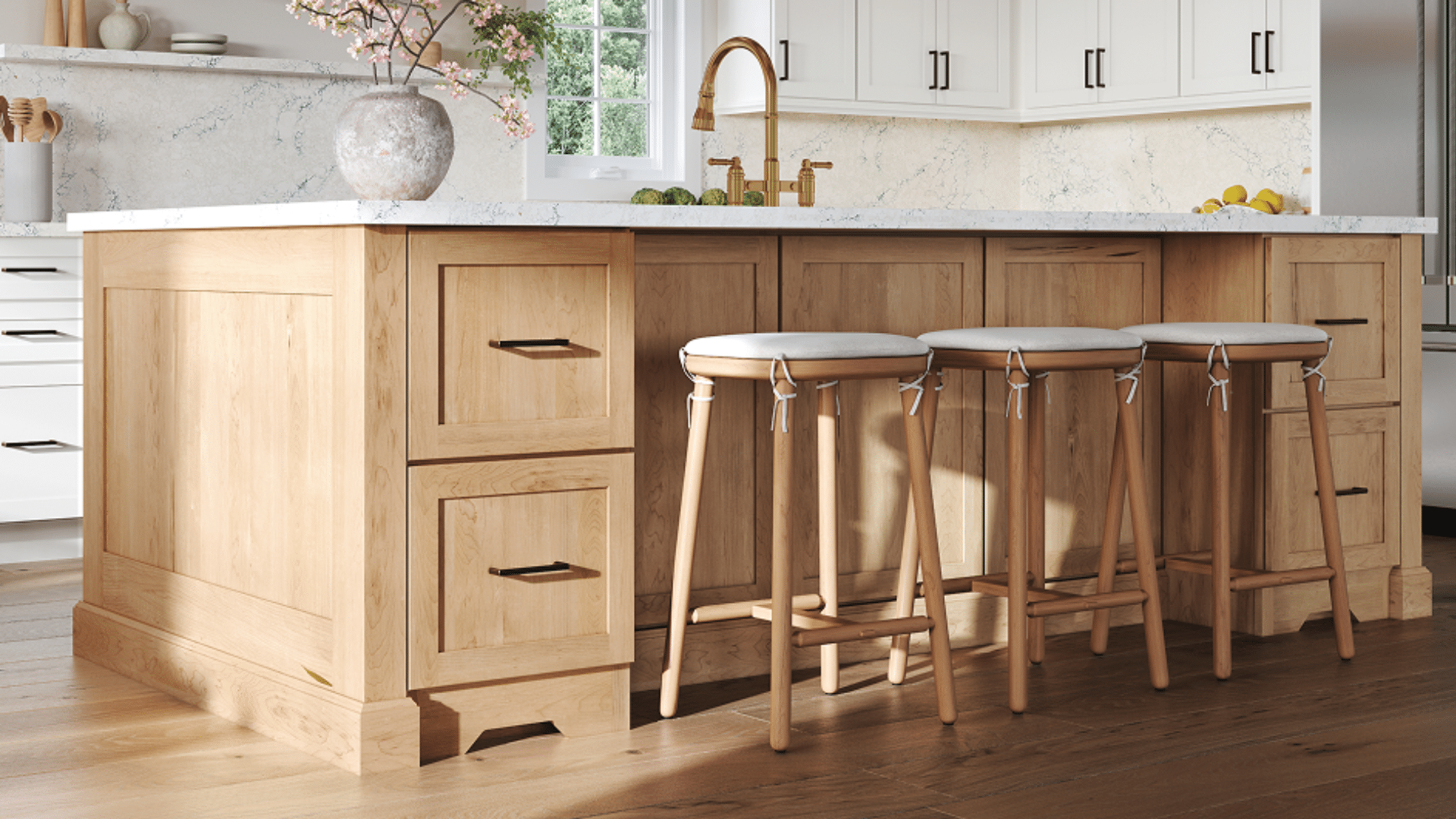
Light Maple (#E6CDA9) offers the perfect middle ground between natural and stained finishes. With an LRV of 60, this creamy beige tone adds just enough color to define the wood grain without making dramatic changes.
I recommend Light Maple for beginners who want to play it safe, or for pieces that need to coordinate with existing light wood furniture.
- Pros: Suitable for any decorating style, easy to match with existing furniture, and provides good protection while maintaining a natural wood appearance.
- Cons: Can look boring in spaces that need more visual interest, shows watermarks and stains easily, and may fade unevenly in direct sunlight over time.
Factors Affecting Maple Stain Appearance
When staining maple wood, its dense grain and subtle figure can produce surprisingly inconsistent results. Understanding the various elements that influence stain appearance is crucial for achieving your desired finish.
| Factor | Description |
|---|---|
| Grain Pattern & Density | Uneven grain causes blotchy stain absorption. |
| Wood Preparation | Poor sanding affects stain penetration and appearance. |
| Moisture Content | Damp wood resists stain and causes uneven tones. |
| Stain Type | Different stains (oil, water, gel) affect color and control. |
| Pre-Stain Conditioner | Helps reduce blotchiness by evening out absorption. |
| Application Technique | Method and timing change how evenly the stain is applied. |
| Color Choice | Dark stains show more blotches; light stains look more natural. |
Maintaining Your Maple Wood Finish
Maintaining your maple wood finish is essential to preserving its natural beauty, durability, and shine over time. Proper care involves regular cleaning, gentle handling, and timely refinishing to avoid damage and discoloration.
- Regularly dust maple surfaces with a soft microfiber cloth to remove dirt and debris without scratching.
- Clean with a slightly damp cloth using mild soap and water; avoid excess moisture, which can damage the finish.
- Use furniture polish designed specifically for wood to enhance shine and protect the finish.
- Avoid abrasive cleaners or rough scrubbing that can wear down the finish or cause scratches.
- Place protective pads under furniture or heavy objects to prevent dents and gouges.
- Avoid prolonged exposure to direct sunlight to reduce fading or discoloration.
- When refinishing, sand the surface smoothly, starting with coarse and progressing to fine grit to prepare for a new finish.
- Use pre-stain wood conditioner before staining to reduce blotchiness often seen in maple wood
Best Stains for Maple Wood
Maple wood is prized for its smooth grain and light color, but its dense structure can make staining tricky. Choosing the right stain is essential to enhance its natural beauty without blotching.
| Stain | Type | Best For | Highlights |
|---|---|---|---|
| General Finishes Gel | Gel (oil-based) | Furniture, cabinets | Even coverage, low blotching |
| Minwax + Pre-Stain | Oil-based | Floors, trim | Pre-stain improves consistency |
| Varathane Premium | Oil-based | General interior use | Fast drying, vibrant color |
| Rubio Monocoat 2C | Hardwax oil | High-end furniture | Eco-friendly, durable, natural look |
| TransTint Dye | Dye (water/alcohol) | Artistic projects | Vivid color, needs topcoat |
The Bottom Line
Choosing the right stained maple doesn’t have to be overwhelming anymore.
I’ve shown you how different maple stain color chart are, and now you have the tools to make smart decisions for your furniture projects.
Your furniture makeover success depends on preparation and patience. Take your time with each step, and don’t rush the drying process.
Grab some test samples and begin experimenting. I’d love to hear about your results!


